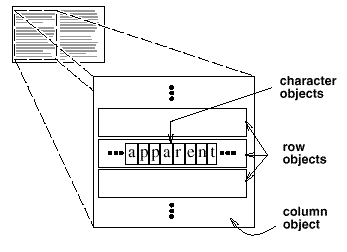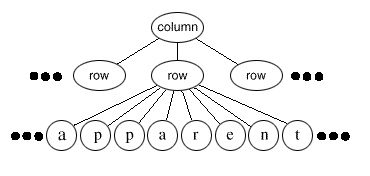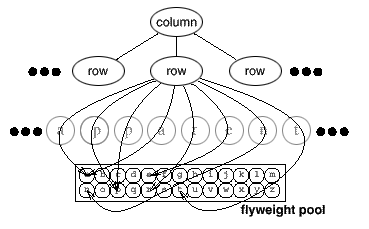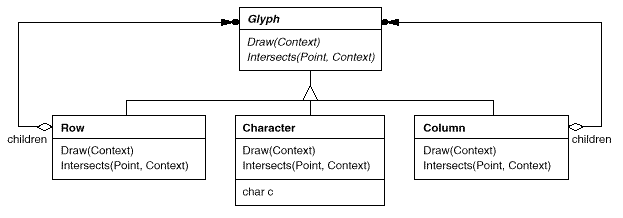
Applied Design Patterns with Java
Structural :: Flyweight (195) {C ch 14}
Intent
Use sharing to support large numbers of fine-grained objects
efficiently.
Motivation
Some applications could benefit from using objects throughout
their design, but a naive implementation would be prohibitively expensive. Most document editor implementations
have text formatting and editing facilities that are modularized. Object-oriented document editors typically use
objects to represent embedded elements like tables and figures. They usually don't use an object for each character
in the document, even though it would promote flexibility at the finest levels in the application. Characters and
embedded elements could then be treated uniformly with respect to how they are drawn and formatted. The application
could be extended to support new character sets without disturbing other functionality. The application's object
structure could mimic the document's physical structure. The following diagram shows how a document editor can
use objects to represent characters.

The drawback of such a design is its cost. Even moderate-sized documents may require hundreds of thousands of character
objects, which will consume lots of memory and may incur unacceptable run-time overhead. The Flyweight
pattern describes how to share objects to allow their use at fine granularities without prohibitive cost. A Flyweight
is a shared object that can be used in multiple contexts simultaneously. The Flyweight acts as an independent
object in each context—it's indistinguishable from an instance of the object that's not shared. Flyweights
cannot make assumptions about the context in which they operate.
The key concept here is the distinction between intrinsic
and extrinsic state. Intrinsic state is stored in the flyweight; it consists of information that's independent
of the flyweight's context, thereby making it sharable. Extrinsic
state depends on and varies with the flyweight's context and therefore can't be shared. Client objects are responsible for passing extrinsic state to the Flyweight
when it needs it. Flyweights model concepts or entities that are normally too plentiful to represent
with objects. For example, a document editor can create a Flyweight for each letter of the alphabet. Each Flyweight
stores a character code, but its coordinate position in the document and its typographic style can be determined
from the text layout algorithms and formatting commands in effect wherever the character appears. The character code is intrinsic state, while the other information
is extrinsic. Logically there is an object for every
occurrence of a given character in the document:

Physically, however, there is one shared Flyweight object per character, and it appears in different contexts in the document structure. Each occurrence of a particular character object refers to the same instance in the shared pool of Flyweight objects:

The class structure for these objects is below. Glyph is the abstract class
for graphical objects, some of which may be Flyweights. Operations that may depend on extrinsic state have it passed to them as a parameter.
For example, Draw and Intersects must know which context the glyph is in before they can do their job.

A Flyweight representing the letter "a" only stores the corresponding character
code; it doesn't need to store its location or font. Clients supply the context-dependent information that the
flyweight needs to draw itself. A Row glyph knows where its children should draw themselves so that they are tiled
horizontally. Thus it can pass each child its location in the draw request.
Because the number of different character objects is far less than the number of characters in the document, the
total number of objects is substantially less than what a naive implementation would use. A document in which all
characters appear in the same font and color will allocate on the order of 100 character objects (roughly the size
of the ASCII character set) regardless of the document's length. And since most documents use no more than 10 different
font-color combinations, this number won't grow appreciably in practice. An
object abstraction thus becomes practical for individual characters.